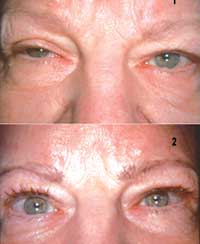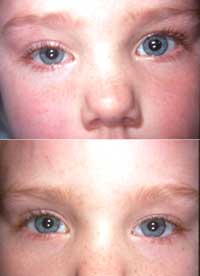Minimal ptosis surgery technique eliminates need for incisions
Cosmetic surgeons can avoid levator muscle strengthening procedures by resecting Müller’s muscle with sutures.
 Essam A. El Toukhy |
It is possible for cosmetic surgeons to treat ptosis without using incisions or manipulating the levator muscle, according to one ophthalmologist.
Essam A. El Toukhy, MD, FRCOph, deputy director of the National Eye Institute in Cairo, has modified a suture-based technique he has used for the past 10 years to successfully treat adults and children with the condition.
“I was trained on using this technique during my fellowship. We were not using it a lot actually, but the customers now want a procedure with no incision, so this has been appealing,” Dr. El Toukhy told Ocular Surgery News during a telephone interview. “I’ve done a lot of modifications on it, so I have been using it much more often than before.”
The technique is called minimal ptosis surgery and requires excellent levator muscle function and good response to Neo-Synephrine 2.5% or less for the preoperative measurements, according to Dr. El Toukhy.
Preop examination paramount
|
Images: El Toukhy EA |
The surgery can be performed in cases of congenital ptosis of 1 mm to 2 mm and acquired ptosis of 3 mm to 4 mm. The amount of ptosis in each case will determine the amount of resection of Müller’s muscle required, Dr. El Toukhy said.
“What is important … is the preoperative examination to determine how much of the Müller’s muscle should be resected in order to achieve the required lid elevation,” he said.
In addition to checking for the severity of the ptosis, the surgeon must instill one drop of Neo-Synephrine 2.5% to determine the lid response.
“You instill one drop in the eye and wait for 2 to 3 minutes to see how much the lid will elevate, and depending on this, you determine the amount of muscle strengthening needed,” he said.
According to Dr. El Toukhy, standard Neo-Synephrine 10% should not be used because it will produce an invalid response of the eyelid.
“If you use the [Neo-Synephrine] 10% ... you can get a full positive result during the preoperative exam. Then you get a lower result of the eyelid postop. It can give you a false impression that the lid will be lifted high up,” he said.
Dr. El Toukhy said he has modified this step by diluting the Neo-Synephrine to 1.5% to increase the accuracy of the preop measurement.
Resecting Müller’s muscle
|
|
Once the preop measurements are taken, the surgeon must lift the conjunctiva and Müller’s muscle to the determined position using a Desmarre retractor and clamp the required amount to be lifted.
“It is important to make sure that you are only lifting the conjunctiva and Müller’s muscle and that you are not including the levator muscle in your lift,” Dr. El Toukhy said.
Although a hemostat can be used in this step, Dr. El Toukhy said a Putterman clamp is preferable because it provides holes through which the suture needle can be passed.
Once Müller’s muscle and the conjunctiva are clamped, the surgeon can begin suturing from the skin side at the crease of the lift using a monofilament suture such as Prolene or nylon.
The suture is passed back and forth across the lid to the other side where the suture must emerge on the skin side.
According to Dr. El Toukhy, the suture can be externalized in adults so it can be used to adjust the lid after surgery.
“In adults, a slight modification is to exteriorize the suture and to remove it 4 to 7 days after the procedure as a form of adjustment,” he said. “If the lid position is slightly higher than you want, you remove the suture earlier at the fourth or fifth day. If the lid position is slightly lower than you want, then you remove the suture later at the sixth or seventh postop day.”
When operating on children, adjustable sutures cannot be used and therefore the suture knot must be concealed, he said.
Clinical experience
In order to demonstrate the efficacy of the procedure, Dr. El Toukhy conducted a study in which he operated on 124 eyelids of 96 patients with a mean preoperative margin reflex distance of 1.7 mm, ranging from 1 mm to 3.5 mm.
Mean follow-up was 17 months and ranged from 5 to 28 months, he said.
All procedures were performed with a Putterman’s clamp and 6-0 silk for marking and 5-0 Prolene sutures.
According to the results, there was a mean margin reflex distance improvement of 2.1 mm, ranging from 1 mm to 3.2 mm.
Dr. El Toukhy said he observed no changes in the lid contour, and he achieved symmetry in all bilateral cases.
There was some postop transient lid edema lasting for a few days, but there was no quantitative decrease in tear secretion.
According to Dr. El Toukhy, removing the need for incisions in these procedures is making all the difference for his patients.
“This is one of the beauties of this surgery, and that’s why it is appealing to a lot of patients rather than levator muscle surgery. It is easier and safer,” he said.
For more information:
- Essam A. El Toukhy, MD, FRCOph, professor of ophthalmology at Cairo University and deputy director of the National Eye Institute of Egypt, can be reached at 14- A Dr. El Sobki St., #23, Dokki, Cairo, Egypt; +2012-312-3103; fax: +202-335-6017; e-mail: eeltoukhy@yahoo.com.
- Jared Schultz is an OSN Staff Writer who covers all aspects of ophthalmology. He focuses geographically on Europe and the Asia-Pacific region.


